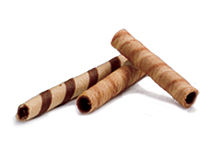Caramel
The caramel or caramel ( French: couleur "color") is a black food coloring that is approved in Europe as a food additive for numerous foods. The maximum quantity indication “qs” ( Quantum satis ) means that only “the amount technically required in the individual case” may be added and only “if this does not mislead the consumer”.
Caramelization is used to produce caramel , in which the conditions are adjusted to polymer end products. Heating glucose syrup with sulfuric acid in the presence of ammonia leads to colored products. To increase the solubility and stability can sulfonic acid by addition of sulphite to double bonds are bound. Caramel tastes bitter.
Classification
The caramel colors are classified according to the reaction accelerator.
| class | designation | E number | use |
|---|---|---|---|
| I. |
Simple color or caustic color |
E 150a | Highly alcoholic products |
| II | Caustic sulphite couleur | E 150b | Alcopops , sausages, vinegar |
| III | Ammonia couleur | E 150c | Beer and other alcoholic beverages, acidic foods |
| IV | Ammonium sulfite couleur | E 150d | acidic foods, non-alcoholic soft drinks (e.g. cola ) |
use

Sugar couleur is used to color drinks such as malt beer , whiskey , alcopops , rum , lemonades such as cola and ginger ale , as well as for jams , sausages , instant sauces, vinegar and confectionery . Zuckercouleur is available in small containers in grocery stores and can be used in everyday kitchens to color desserts and especially (roast) sauces.
health
Carousels are considered to be harmless to health. A permitted daily dose of 300 mg / kg body weight applies . Exposure to the caramel components THI ( 2-acetyl-4-tetrahydroxybutylimidazole ), 4-MEI ( 4-methylimidazole ) and SO 2 is harmless. For 5-HMF ( 5-hydroxymethylfurfural ) and furan , which can be contained in questionable amounts, the specifications should contain limit values in the future.
Ammonium sulfite caramel (E 150d) caused cramps in animal experiments at high concentrations and reduced the number of white blood cells. There are legal limit values and high consumption is not recommended.
Legal situation
Zuckercouleur is subject to declaration, but is approved for food with the note qs . It is not permitted to use caramel in order to simulate other properties. For example, the addition of caramel to bread is forbidden, as it could simulate a darker type of flour or a higher proportion of rye; the addition is only permitted for “malt bread”. A total of 30 product groups may not be colored, including dairy products, milling products, egg products, tea, roasted coffee; others only with restrictions.
Individual evidence
- ↑ Entry in Duden
- ↑ a b c d e Annex 1 (to Section 3, Paragraph 1 and Section 7) ZZulV : Additives that are approved for coloring foods or for achieving color effects on foods
- ^ Hans-Dieter Belitz , Werner Grosch , Peter Schieberle : Textbook of food chemistry . 6th completely revised edition. Springer, Berlin / Heidelberg 2008, ISBN 978-3-540-73201-3 , p. 274 , doi : 10.1007 / 978-3-540-73202-0 .
- ↑ Ternes, Täufel, Tunger, Zobel: Food Lexicon . Behr's Verlag, Hamburg 2005, ISBN 3-89947-165-2 .
- ↑ Entry on E 150a: Plain caramel in the European database on food additives, accessed on June 16, 2020.
- ↑ Entry on E 150b: Caustic sulphite caramel in the European database for food additives, accessed on June 16, 2020.
- ↑ Entry on E 150c: Ammonia caramel in the European database on food additives, accessed on June 16, 2020.
- ↑ Entry on E 150d: Sulphite ammonia caramel in the European database for food additives, accessed on June 16, 2020.
- ↑ Scientific Opinion on the re-evaluation of caramel colors (E 150 a, b, c, d) as food additives , EFSA Journal 2011; 9 (3): 2004 [103 pp.]. doi : 10.2903 / j.efsa.2011.2004
- ↑ das-ist-drin.de: E 150 d - ammonium sulphite caramel

